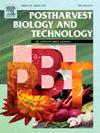转录组相关代谢组学揭示了假单胞菌 B2 侵染导致双孢蘑菇褐斑病的调控机制
IF 6.4
1区 农林科学
Q1 AGRONOMY
引用次数: 0
摘要
假单胞菌引起的褐变是造成双孢蘑菇(A. bisporus)收获后变色的主要因素。然而,假单胞菌侵染双孢蘑菇后引起的生理变化在很大程度上仍未得到研究。本研究证实了假单胞菌 B2 在造成双孢蘑菇严重褐斑中的作用。通过提高苯丙氨酸氨解酶(PAL)、4-香豆酸-CoA 连接酶(4CL)、多酚氧化酶(PPO)和酪氨酸酶(TYR)参与酚类、类黄酮和酶促反应的活性,虫害加速了组织褐变。转录组和代谢组分析显示,氨基酸生物合成、色氨酸和酪氨酸代谢发生了变化,影响了特定代谢物的基因转录。酪氨酸代谢途径中的 AbPPO1 和 AbPPO2 是褐变发生过程中的关键基因。发现了 19 个与 B2 假单胞菌侵染蘑菇的疾病调控密切相关的转录因子。本文章由计算机程序翻译,如有差异,请以英文原文为准。
Transcriptome-associated metabolomics revealed the regulatory mechanism of Pseudomonas B2 infestation leading to brown spot disease of Agaricus bisporus
Pseudomonas-induced browning is a primary factor in postharvest discoloration of Agaricus bisporus (A. bisporus). However, the physiological alterations ensuing Pseudomonas infestation in A. bisporus remain largely unexplored. This study affirmed Pseudomonas B2’s role in causing severe brown spots in A. bisporus. The infestation accelerates tissue browning through heightened phenylalanine aminolyase (PAL), 4-coumarate-CoA ligase (4CL), polyphenol oxidase (PPO) and tyrosinase (TYR) activities involved in phenolic, flavonoid, and enzymatic reactions. Transcriptome and metabolome analyses revealed changes in amino acid biosynthesis, tryptophan and tyrosine metabolism affecting gene transcription for specific metabolites. The AbPPO1 and AbPPO2 in the tyrosine metabolism pathway are key genes in the development of browning. Nineteen transcription factors closely associated with regulating diseases in Pseudomonas B2-infested mushrooms were identified.
求助全文
通过发布文献求助,成功后即可免费获取论文全文。
去求助
来源期刊

Postharvest Biology and Technology
农林科学-农艺学
CiteScore
12.00
自引率
11.40%
发文量
309
审稿时长
38 days
期刊介绍:
The journal is devoted exclusively to the publication of original papers, review articles and frontiers articles on biological and technological postharvest research. This includes the areas of postharvest storage, treatments and underpinning mechanisms, quality evaluation, packaging, handling and distribution of fresh horticultural crops including fruit, vegetables, flowers and nuts, but excluding grains, seeds and forages.
Papers reporting novel insights from fundamental and interdisciplinary research will be particularly encouraged. These disciplines include systems biology, bioinformatics, entomology, plant physiology, plant pathology, (bio)chemistry, engineering, modelling, and technologies for nondestructive testing.
Manuscripts on fresh food crops that will be further processed after postharvest storage, or on food processes beyond refrigeration, packaging and minimal processing will not be considered.
 求助内容:
求助内容: 应助结果提醒方式:
应助结果提醒方式:


